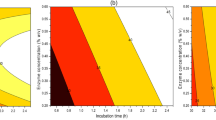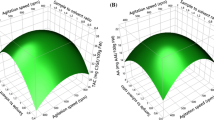Abstract
In the current study, debittering of white mahlab (Prunus mahaleb L.) juice using polystyrene resins was investigated and optimized using the Box–Behnken response surface methodology. The effects of independent variables including resin type (cation exchange resin, anion exchange resin, and 50:50 cation/anion exchange resin), resin dosage (0.05, 0.075, and 0.1 g/mL) and agitation speed (50, 150, and 250 rpm) on total phenolic content, total flavonoid content, total anthocyanin content (TAC), antioxidant activity, and bitterness of white mahlab juice were studied. Effects of resin type and dosage were found to be significant (p < 0.05) for all responses. A dosage of 0.05 g/mL of the anion exchange resin and an agitation speed of 250 rpm were selected as the optimum conditions based on minimum bitterness (2.42) and maximum TAC (0.018 g/mol). We could conclude that the anionic resin can greatly reduce the intensity of bitterness and maintain the composition and characteristics of the P. mahaleb juice.

Similar content being viewed by others
References
Manthey JA, Guthrie N, Grohmann K. Biological properties of citrus flavonoids pertaining to cancer and inflammation. Curr. Med. Chem. 8: 135–153 (2001)
Wu X, Gu L, Prior RL, McKay S. Characterization of anthocyanins and proanthocyanidins in some cultivars of Ribes, Aronia, and Sambucus and their antioxidant capacity. J. Agr. Food Chem. 52: 7846–7856 (2004)
Aydin C, Ogut H, Konak M. Some physical properties of Turkish Mahaleb. Biosyst. Eng. 82: 231–234 (2002)
Prakash S, Singhal RS, Kullkarni PR. Enzymic debittering of Indian grapefruit (Citrus paradisi) juice. J. Sci. Food Agr. 82: 394–397 (2002)
Sekeroglu G, Fadiloglu S, Gögus F. Immobilization and characterization of naringinase for the hydrolysis of naringin. Eur. Food Res. Technol. 224: 55–60 (2006)
Mongkolkul P. Debittering of tangerine Citrus reticulata Blanco juice by cyclodextrin polymer. J. Incl. Phenom. Macro. 56: 167–170 (2006)
Binello A, Robaldo B, Barge A, Cavalli R, Cravotto G. Synthesis of cyclodextrin-based polymers and their use as debittering agents. J. Poly. Sc. 107: 2549–2557 (2008)
Tallarico P, Todisco S, Drioli E. Use of ultra-filtration in the preventing of orange juice bitterness and effects on the aroma compounds distribution. Agro Food Ind. Hi. Tech. 9: 32–36 (1998)
Pritchett DE. Extraction of bitter principle from navel orange juice. U.S. Patent. 2: 816–833 (1957)
Ribeiro MHL. Silveira D, Ferreira-Dias S. Selective adsorption of limonin and naringin from orange juice to natural and synthetic adsorbents. Eur. Food Res. Technol. 215: 462–471 (2002)
Matthews RF, Rouseff RK, Manlan M. Removal of limonin and naringin from citrus juice by styrene divinyl benzene resins. Food Technol. 44: 130 (1990)
Couture R, Rouseff R. Debittering and deacidifying sour orange (Citrus aurantium) juice using neutral and anion exchange resins. Food Sci. Technol. 57: 380–384 (1992)
Xu RH, Cheng N, Huang W, Gao H, Deng JJ, Cao W. Effects of the processing steps on parathion levels during honey production and parathion removal by macroporous adsorption resins. Food Control. 23: 234–237 (2012)
Liu Q, Gao Y. Binary adsorption isotherm and kinetics on debittering process of ponkan (Citrus reticulata Blanco) juice with macroporous resins. LWT-Food Sci. Technol. 63: 1245–1253 (2015)
Bao Y, Yuan F, Zhao X, Liu Q, Gao, Y. Equilibrium and kinetic studies on the adsorption debittering process of ponkan (Citrus reticulate Blanco) juice using macroporous resins. Food Bioprod. Process. 94: 199–207 (2015)
Metrouh-Amir H, Duarte CM, Maiza F. Solvent effect on total phenolic contents, antioxidant, and antibacterial activities of Matricaria pubescens. Ind. Crop. Prod. 67: 249–256 (2015)
D’Abrosca B, Pacifico S, Cefarelli G, Mastellone C, Fiorentino A. ‘Limoncella’ apple, an Italian apple cultivar: Phenolic and flavonoid contents and antioxidant activity. Food Chem. 104: 1333–1337 (2007)
Krawczyk U, Petri G. Application of RP-HPLC and spectrophotometry in standardization of bilberry anthocyanin extract. Arch. Pharm. 325: 147–149 (1992)
Sharma S, Kori S, Parmar A. Surfactant mediated extraction of total phenolic contents (TPC) and antioxidants from fruits juices. Food Chem. 185: 284–288 (2015)
Boulekbache-Makhlouf L, Medouni L, Medouni-Adrar S, Arkoub L, Madani K. Effect of solvents extraction on phenolic content and antioxidant activity of the byproduct of eggplant. Ind Crops Prod. 49: 668–674 (2013)
Guardaa A, Rosellb CM, Beneditob C, Galotto MJ. Different hydrocolloids as bread improvers and antistaling agents. Food Hydrocoll. 18: 241–247 (2004)
Kruk ZA, Yun H, Rutley DL, Lee EJ, Kim YJ, Jo C. The effect of high pressure on microbial population, meat quality and sensory characteristics of chicken breast fillet. Food Control. 22: 6–12 (2011)
Vardin H, Fenercioǧlu H. Study on the development of pomegranate juice processing technology: clarification of pomegranate juice. Mol. Nutr. Food Res. 47: 300–303 (2003)
Jalili Safaryan M, Ganjloo A, Bimakr M, Zarringhalami S. Optimization of ultrasound-assisted extraction, preliminary characterization and in vitro antioxidant activity of polysaccharides from green pea pods. Foods. 1–15: 78 (2016)
Ibeas V, Correia AC, Jordão AM. Wine tartrate stabilization by different levels of cation exchange resin treatments: impact on chemical composition, phenolic profile and organoleptic properties of red wines. Food Res. Int. 69: 364–372 (2015)
Conidi C, Rodriguez-Lopez AD, Garcia-Castello EM, Cassano A. Purification of artichoke polyphenols by using membrane filtration and polymeric resins. Sep. Purif. Technol. 144: 153–161 (2015)
Kammerer DR, Carle R, Stanley RA, Saleh ZS. Pilot-scale resin adsorption as a means to recover and fractionate apple polyphenols. J. Agr. Food Chem. 58: 6787–6796 (2010)
Soto ML, Moure A, Domínguez H, Parajó JC. Recovery, concentration and purification of phenolic compounds by adsorption: A review. J. Food Eng. 105: 1–27 (2011)
Cavia-Saiz M, Muñiz P, Ortega N, Busto MD. Effect of enzymatic debittering on antioxidant capacity and protective role against oxidative stress of grapefruit juice in comparison with adsorption on exchange resin. Food Chem. 125: 158–163 (2011)
Bretag J, Kammerer DR, Jensen U, Carle R. Evaluation of the adsorption behavior of flavonoids and phenolic acids onto a food-grade resin using a D-optimal design. Eur. Food Res. Technol. 228: 985–999 (2009)
Kammerer J, Boschet J, Kammerer DR, Carle R. Enrichment and fractionation of major apple flavonoids, phenolic acids and dihydrochalcones using anion exchange resins. LWT-Food Sci. Technol. 44: 1079–1087 (2011)
Mira H, Leite P, Ricardo-Da-Silva J, Curvelo-Garcia AS. Use of ion exchange resins for tartrate wine stabilization. J. Int. Sci. Vigne Vin. 40: 223–246 (2006)
Lasanta C, Caro I, Pérez L. The influence of cation exchange treatment on the final characteristics of red wines. Food Chem. 138: 1072–1078 (2013)
Johnson RL, Chandler BV. Adsorptive removal of bitter principles and titratable acid from citrus juices. Food Technol. 42: 130–137 (1988)
Mitchell DH, Pearce RM, Smith CB, Brown ST. Removal of bitter naringin and limonin from citrus juices containing the same. U.S. Patent. 4: 514–427 (1985)
Shaw PE, Wilson CW. Reduction in bitterness in grapefruit juice with 8-Cyclodextrin polymer in a continuous-flow process. J. Food Sci. 50: 1205–1207 (1985)
Johnson RL, Chandler BV. Ion exchange and adsorbent resins for removal of acids and bitter principles from citrus juices. J. Sci. Food Agr. 36: 480–484 (1985)
Galato D, Ckless K, Susin FM, Giacomelli C, Ribeiro-do-Vale RM, Spinelli A. Antioxidant capacity of phenolic and related compounds: correlation among electrochemical, visible spectroscopy methods and structure antioxidant activity. Redox Rep. 6: 243–250 (2001)
Franke SIR, Ckless K, Silveira JD, Rubensam G, Brendel M, Erdtmann B. Study of antioxidant and mutagenic activity of different orange juices. Food Chem. 88: 45–55 (2004)
Author information
Authors and Affiliations
Corresponding author
Ethics declarations
Conflict of interest
The authors declare no conflict of interest.
Rights and permissions
About this article
Cite this article
Bazrafkan, F., Zarringhalami, S. & Ganjloo, A. Response surface optimization of conditions for debittering of white mahlab (Prunus mahaleb L.) juice using polystyrene resins. Food Sci Biotechnol 26, 1555–1562 (2017). https://doi.org/10.1007/s10068-017-0220-1
Received:
Revised:
Accepted:
Published:
Issue Date:
DOI: https://doi.org/10.1007/s10068-017-0220-1




